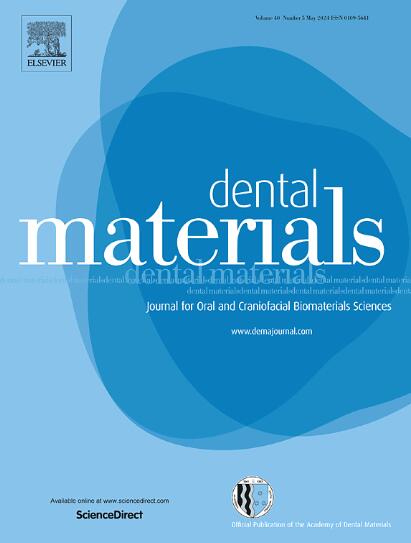Novel matrix formulation for resin composite: Chemical and biomechanical characterization – Part 1
IF 4.6
1区 医学
Q1 DENTISTRY, ORAL SURGERY & MEDICINE
引用次数: 0
Abstract
Objective
This study aimed to investigate the effects of adding cholesteryl methacrylate (CM) monomer to experimental composite resins and evaluate its impact on polymerization shrinkage force (PSF), Knoop microhardness (KHN), sorption and solubility (SS), vulnerability to spontaneous oxidation (VOE), porosity (BES), viscosity (V), and cross-link density (CLD). CM was synthesized, mixed with varying proportions of Bis-GMA, 70 wt% filler particles, and 40 % TEGDMA. The groups tested were: CM0 (60 % Bis-GMA), CM6 (54 % Bis-GMA/6 % CM), CM12 (48 % Bis-GMA/12 % CM), CM18 (42 % Bis-GMA/18 % CM) and CM24 (36 % Bis-GMA/24 % CM). The PSF was evaluated using a universal testing machine. KHN was measured with a 50 g load for 30 s. SS was determined according to ISO 4049:2009. VOE was measured with a three-electrode system in an electrochemical cell. BES images were obtained using an electron microscope to assess porosity. Viscosity was measured through rheological analysis. CLD was estimated from hardness readings before and after ethanol storage.
Results
CM6 (0.34 N) and CM12 (0.34 N) exhibited the lowest PSF values compared to CM0 (0.91 N). For KHN, CM6 (32.03) and CM12 (31.03) had higher values than CM0 (25.83) and were similar to CM18 (29.39) and CM24 (28.64). SS showed no significant differences among the groups. VOE indicated low vulnerability across all groups. CM12 had greater porosity compared to CM0 in BES images. CM0 had the lowest viscosity among the groups. No differences in CLD were observed among CM0, CM12, CM18, and CM24 regarding softening effects.
Significance
Adding CM to Bis-GMA/TEGDMA composite resins can reduce polymerization shrinkage force and increase the initial Knoop microhardness without affecting the other properties studied.
树脂复合材料的新型基质配方:化学和生物力学特性分析 - 第 1 部分。
研究目的本研究旨在探讨在实验复合树脂中添加胆固醇甲基丙烯酸酯 (CM) 单体的效果,并评估其对聚合收缩力 (PSF)、努氏显微硬度 (KHN)、吸附性和溶解性 (SS)、易自发氧化性 (VOE)、孔隙率 (BES)、粘度 (V) 和交联密度 (CLD) 的影响。将 CM 与不同比例的 Bis-GMA、70 wt% 的填料颗粒和 40 % 的 TEGDMA 混合合成。测试组为CM0 (60 % Bis-GMA)、CM6 (54 % Bis-GMA/6 % CM)、CM12 (48 % Bis-GMA/12 % CM)、CM18 (42 % Bis-GMA/18 % CM) 和 CM24 (36 % Bis-GMA/24 % CM)。PSF 使用万能试验机进行评估。根据 ISO 4049:2009 标准测定 SS。VOE 通过电化学电池中的三电极系统进行测量。使用电子显微镜获得 BES 图像,以评估孔隙率。粘度通过流变分析进行测量。根据乙醇储存前后的硬度读数估算 CLD:与 CM0(0.91 N)相比,CM6(0.34 N)和 CM12(0.34 N)的 PSF 值最低。对于 KHN,CM6(32.03)和 CM12(31.03)的值高于 CM0(25.83),与 CM18(29.39)和 CM24(28.64)相似。SS 在各组间无明显差异。所有组的 VOE 值均较低。在 BES 图像中,CM12 的孔隙率高于 CM0。CM0 的粘度在各组中最低。在软化效果方面,CMD 在 CM0、CM12、CM18 和 CM24 之间没有差异:在双-GMA/TEGDMA 复合树脂中添加 CM 可降低聚合收缩力并提高初始努氏显微硬度,而不会影响所研究的其他性能。
本文章由计算机程序翻译,如有差异,请以英文原文为准。
求助全文
约1分钟内获得全文
求助全文
来源期刊

Dental Materials
工程技术-材料科学:生物材料
CiteScore
9.80
自引率
10.00%
发文量
290
审稿时长
67 days
期刊介绍:
Dental Materials publishes original research, review articles, and short communications.
Academy of Dental Materials members click here to register for free access to Dental Materials online.
The principal aim of Dental Materials is to promote rapid communication of scientific information between academia, industry, and the dental practitioner. Original Manuscripts on clinical and laboratory research of basic and applied character which focus on the properties or performance of dental materials or the reaction of host tissues to materials are given priority publication. Other acceptable topics include application technology in clinical dentistry and dental laboratory technology.
Comprehensive reviews and editorial commentaries on pertinent subjects will be considered.
 求助内容:
求助内容: 应助结果提醒方式:
应助结果提醒方式:


